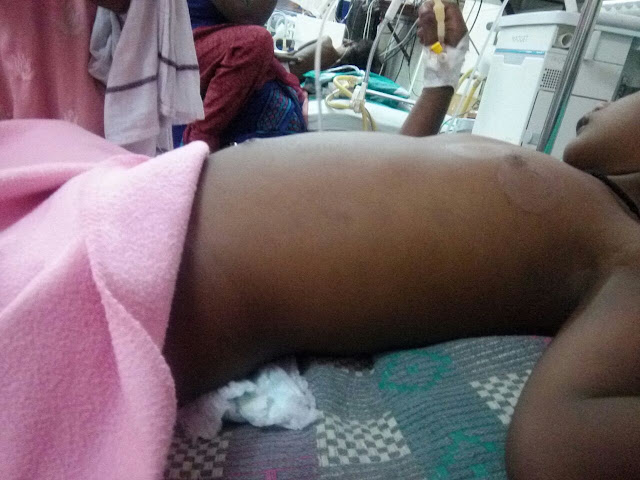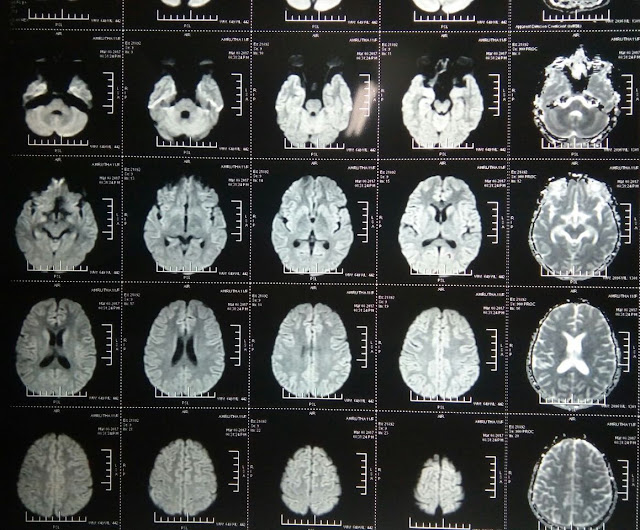Three year old girl only child born to a young couple was diagnosed as Nephrotic syndrome at one and half years of age. No consanguinity , no family history of kidney disorders . Antenatal natal ,postnatal developmental history all normal .
Was treated by an "adult nephrologist" with daily treatment .A different schedule was used (Not ISKDC ) Daily treatment 2 mg/kg once a day till remission and lower dose continuation .Total duration was two months . She came to remission in the first episode . She had relapses many times during this one and half years . She was on daily steroid through out . Increasing doses while on proteinuria ,but continuing daily treatment almost always the dose was almost one mg per kg .
She was put on cyclophosphamide orally 2.5 mg /kg for three months last year
She was on Tab levamizol 2.5 mg per kg thrice a day for six months
She is now on 20 mg daily steroid
They noticed some difference in the way she looked at things and noticed some white shadow inside her left eye .
On examination, She is stunted. weight normal , Blood pressure above 95 centile both systolic and diastolic .
Obviously she is a case of Steroid dependent nephrotic syndrome. Poorly managed and followed up.
Critically analyzing,
1.Duration of steroid in the ISKDC regime or other where at least three months of adequate dose steroid would have been better to reduce the number of relapses
2.What about renal biopsy? Renal biopsy was not done .Is it justified to put her on Cyclophosphamide ?
Yes , she responded to steroid , only thing she relapsed early and frequent relapses Every time she responds to steroid . Total cumulative dose of steroid caused toxicity . Renal biopsy is not indicated in cases of steroid dependent or frequent relapsing.
We may choose one of the policies for treatment of these cases.
Most favored one is taper slowly ,titrate and continue low dose steroid .If the needed dose is 0.5 or .0.7 mg per kg ,continue for one and half years. Of course monitor for toxicity .
If the minimum dose needed to prevent relapse is above this dose ,toxicity is high. ( or toxicity already occurred go for higher options . Here cyclophosphamide is the best . Either oral for three months as in the above case or monthly pulse for six months.
3.Here proper monitoring of toxicity was lacking .There is stunting , Hypertension and cataract well established.
Evaluation from Our institution
Her blood sugar, Electrolytes, calcium magnesium are normal
Her system functions are normal , Hemoglobin is 11 grams
Our Plans .
She is posted for cataract surgery next week
After surgery What about her management after cataract surgery?
Can we continue steroid ?
if not What other drugs ?
My first impression was
" we cant continue steroids as she had all the major three complications. Now any way we have to continue the steroid till her surgery is over as her HPA axis is likely to be suppressed and surgery to be done under stress dose"
After that ?
She had already had a three month course of cyclophosphamide. So among the other choices Mycophenolate mofetil is the best. Tacrolymus and cyclosporin. Out of this we have few patients on MMF very good choice as they tolerate it very well , only thing is the cost .
Should we go for it ? "
We discussed with our ophthalmology team
" Sir , we are going to take away the lens and she needs glass with full correction. Good progressive lenses which can be worn for distant and reading she needs. Right side is normal now. Even if she develops cataract on the right , no problem we ll tackle it the same way. So if you need steroid , no problem , continue steroid "
That is better logic .
Now our task is to bring down the BP ,to make her fit for Aneasthesia . She is put on antihypertensive , Not on Nifedepine only
Here one question remian
OK steroid low dose with good monitoring , dose just enough to prevent relapse is good option for long term.Here BP may come down with lower dose of steroid. and anti hypertensive also we may be able to taper and stop.
What about stunting ? How much of this grade II stunting due to steroid. How much is it due to other reasons . . Will this steroid affect her final height
Both parents average height, we have plotted in graph, mid parental height .
We ll follow up her closely , plot her height and weight for next six months
That is the plan
************************************************************************
Another ocular problem on steroid therapy which is likely to be missed is steroid induced glaucoma
https://www.ncbi.nlm.nih.gov/pmc/articles/PMC4544383/
Patient on long term steroid therapy we monitor most of the complications on daily basis or on follow ups. Eg Hypertension, Secondary diabetes ,infections like tuberculosis and fungal ,steroid induced myopathy ,avascular necrosis of hip osteoporosis etc .
In this context if patient complains of Persisting head ache we ll search for common causes like Hypertension ,sinusitis .We may exclude benign intracranial hypertension ,TBM ,but very often wont think possibility of glaucoma . We ll check the fundus .
But testing for Vision and ocular pressure rarely measured








































